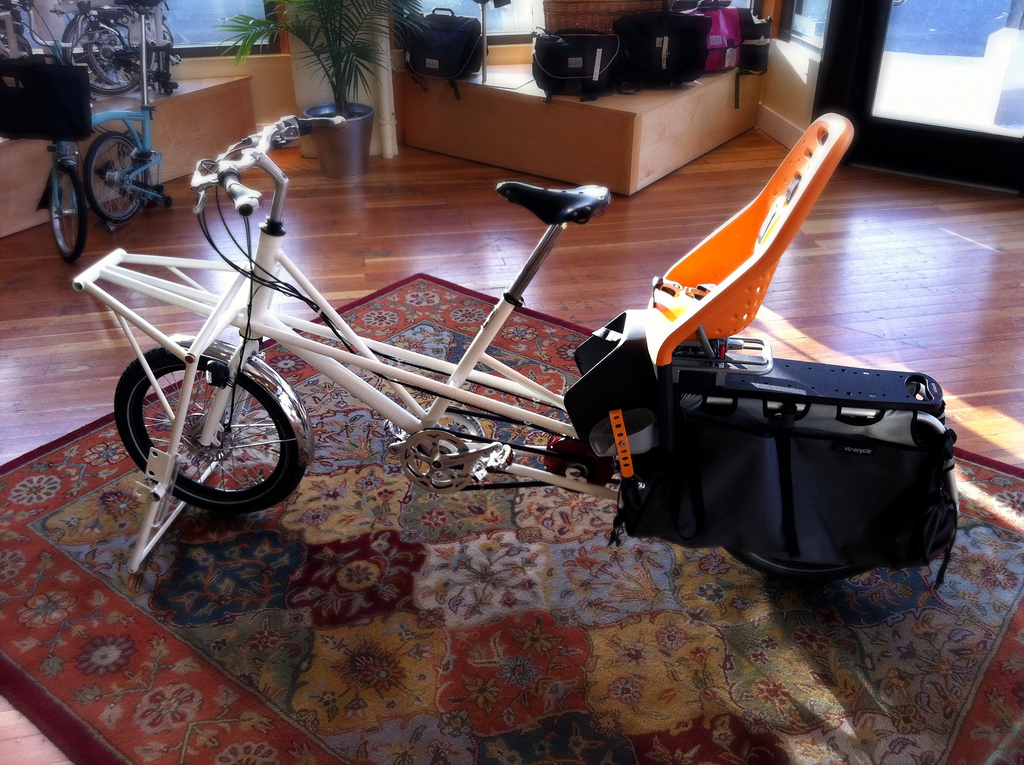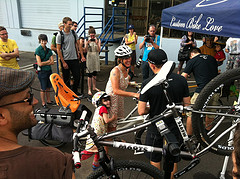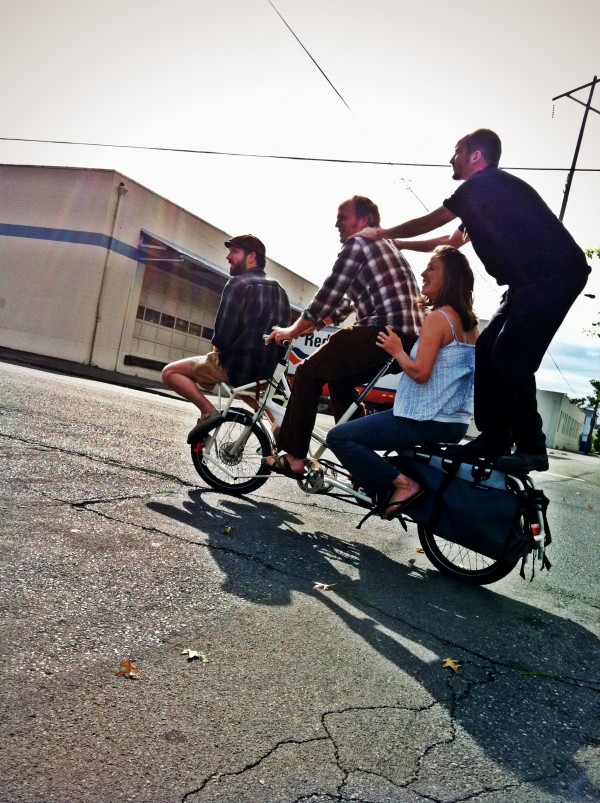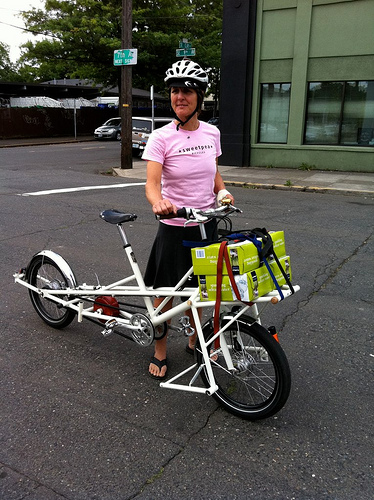Xtravois 2.0, Our Oregon Manifest Bike
The bike Quixote Cycles and we are entering in the Oregon Manifest Constructor’s Challenge is a 20-inch-wheeled Xtracycle-standard longtail with a step-through, one-size-fits-most frame, and a large frame-fixed front rack incorporating a stand. It features also very clean Stokemonkey electric assist integration, including optimal battery stowage. What follows is a super geeky breakdown of the design, its background and rationale.
A travois (trah-voy) is an A-shaped arrangement of poles, loaded near the crossbar with stuff, to be dragged along the ground by human or animal.  It works better than a wheeled cart when traversing very rugged, brushy, or snowy terrain. A similar arrangement of straight twin-lateral tubes occurs in a mixte-style bicycle, where it permits a rider to step through the frame in a manner that enhances lateral rigidity with an isosceles triangle from head tube to rear axle.
It works better than a wheeled cart when traversing very rugged, brushy, or snowy terrain. A similar arrangement of straight twin-lateral tubes occurs in a mixte-style bicycle, where it permits a rider to step through the frame in a manner that enhances lateral rigidity with an isosceles triangle from head tube to rear axle.
Our Constructor’s Challenge bike is a major revision of the travois-inspired elongated mixte I designed in 2003 called Xtravois. 

 This was the first unified-frame rendition of Xtracycle‘s seminal hitchless trailerconcept, a class of bikes now known generically as longtails, with variants now having appeared from numerous artisanal builders as well as companies Surly, Kona, Yuba, Madsen, Rans, Sun, and even Trek. Xtravois was the fifth Xtracycle owned by my household in just two years, and eight years later it is still in weekly, sometimes daily service. I’ve never stopped noodling improvements.
This was the first unified-frame rendition of Xtracycle‘s seminal hitchless trailerconcept, a class of bikes now known generically as longtails, with variants now having appeared from numerous artisanal builders as well as companies Surly, Kona, Yuba, Madsen, Rans, Sun, and even Trek. Xtravois was the fifth Xtracycle owned by my household in just two years, and eight years later it is still in weekly, sometimes daily service. I’ve never stopped noodling improvements.
Goals with the original bike were to improve upon the variable handling, stiffness, strength and aesthetics of Xtracycle’s retrofit extension approach, as well as to serve as a development platform for our patented Stokemonkey electric assist product, designed to let people living in the hilliest places take full advantage of these bikes’ cargo and passenger capacity. Goals with the present revision were to apply insights gained over a decade of personal longtail use and in having sold thousands of utility bikes at Clever Cycles since 2007. In addition to the minimum Constructor’s Challenge required feature set of lights, lock, fenders, stand, and cargo capacity, our feature list includes items often lacking or ill-executed in other longtail designs:
-
A true step-through cross frame design,

 important for ease of use when wearing a skirt or passengers are seated in the rear, that at the same time improves upon the strength and rigidity of typical diamond frames.
important for ease of use when wearing a skirt or passengers are seated in the rear, that at the same time improves upon the strength and rigidity of typical diamond frames.Cross frames, of which mixtes are a type, pre-date cyclocross, and deserve wider revival for utility bikes. In purest form (such as in Pedersens), they are composed entirely of straight, round tubes joined solely at their ends into triangles, with each member in clean compression or tension. Our use of 20″ wheels in an elongated format allows this approach to achieve a distinctive rigor and clarity, obviating the bent or shaped tubes, gussets, or other “remedial” complexities that larger wheel clearance, wheelbase constraints, or cosmetic fancy might compel. It’s probably the most rigid longtail we’ve ever ridden, and that’s beautiful.
Our bike takes structural cues from the Locomotief unisex cross frame, produced in Amsterdam between 1936 and 1955 (still in use!), and also from the magnificent contemporary Filiduo (another view).
Jonathan Reed‘s expert fillet brazing skills found ideal application here, far outside the norms of any available weld-friendly butted tubeset. With fillets able to build up the joints, relatively thin-wall chromium molybdenum steel tubing was used throughout.
-
A sophisticated one-size-fits-most scheme, because utility bikes are frequently shared by a few household or business members.
 Universal sizing also enhances resale, production and distribution economics.
Universal sizing also enhances resale, production and distribution economics.This consists of a tall quill stem and the “Adaptive Seat Tube” embodied in Henry Cutler’s WorkCycles Fr8 line of transport bikes. Note that the very slack seat tube does not meet the bottom bracket, but instead the down tube some inches ahead. This results in the cockpit length varying greatly with saddle height, and the virtual seat tube angle varying the same way it would in a series of separate frame sizes, becoming steeper as the saddle is lowered. A rider of 5’1″ feels as comfortable as one of 6’6″.
-
Moderately upright seating appropriate to the urban environments in which utility bikes are most viable,
 where comfort and the ability to see and be seen above car-top level trump the aerodynamic and “full body workout” rationale for bent-over postures.
where comfort and the ability to see and be seen above car-top level trump the aerodynamic and “full body workout” rationale for bent-over postures.This means not just handlebars that are closer and higher than on bikes built for speed or distance, but a relaxed seat tube angle (below 70 degrees). Bringing the pelvis rearward restores some of the butt-muscle deployment that the uprightness compromises, and makes it easy to put a stabilizing foot down at stops without needing to lean the loaded bike. We find, perhaps counterintuitively, that matching heavy cargo with the high-power ergonomics characteristic of sport bikes (mainly seat tube angles in the 70s) results in a comparatively harsh riding experience: faster, yes, but still feeling all too slow and difficult, as if underscoring the gravity of the load. A lower-intensity, gentler, safer game of momentum management tends to win in miles per year what it may lose in miles per hour, with electric assist options becoming attractive as grades, loads, distances and speed requirements escalate.
-
Flexible, balanced cargo distribution options — a good place to carry large heavy articles when the rear deck is occupied by one or more passengers, or simply full.
 In addition to the open-source Xtracycle-standard rear rack, deck and sling arrangement, this bike incorporates a massive frame-fixed front rack. Heavy loads on frame-fixed racks do not upset steering as with fork-fixed racks, but they require a large height difference between the platform and the handlebars to avoid interference; providing this clearance is another reason behind our choice of 20″ wheels.
In addition to the open-source Xtracycle-standard rear rack, deck and sling arrangement, this bike incorporates a massive frame-fixed front rack. Heavy loads on frame-fixed racks do not upset steering as with fork-fixed racks, but they require a large height difference between the platform and the handlebars to avoid interference; providing this clearance is another reason behind our choice of 20″ wheels.There are practical and psychological benefits to having a front loading option. When hauling your TV to the dump, for instance, loading it in the rear to one side will result in an awkwardly asymmetrical balance, while lashing it to the rear deck makes it harder to watch for narrow load clearances, unwanted shifting, and plasma leakage. The front rack is a sociable place for a large neurotic dog, too.
-
 A robust, extremely stable stand that can easily be deployed and retracted while straddling the fully loaded bike. Integral to the front rack, our double-point center stand is nearly 2′ wide and out of the way of cargo and drivetrain alike. A hasp allows the stand to be locked in deployment, rendering the bike incapable of being rolled or ridden, as a soft security mode.
A robust, extremely stable stand that can easily be deployed and retracted while straddling the fully loaded bike. Integral to the front rack, our double-point center stand is nearly 2′ wide and out of the way of cargo and drivetrain alike. A hasp allows the stand to be locked in deployment, rendering the bike incapable of being rolled or ridden, as a soft security mode.This feature is adopted from historical cycle truck designs as well as the aforementioned Fr8 series of transport bikes.
-
Low center of gravity with low-trail steering, and rear-offset wheel for secure handling with the heaviest loads.
The strong, 20″ wheels improve handling by accommodating a lower center of gravity of both the bike and its cargo. This makes the loaded bike easier to lean into turns, and also to right again. Not only can the racks be positioned nearer the ground while still clearing the wheels, the rear wheel is offset aft in the Xtracycle-standard rack subframe relative to the centered 26″-wheel norm, allowing more of the cargo to sit forward of the rear axle, minimizing the shimmy that afflicts some longtails. Moreover, the rear-offset wheel results in a shorter cantilevered support arm to the rear rack bridge, obviating the truss structures found in other longtails. Finally, a small front wheel accommodates a shorter, stiffer fork for most positive braking response.
Low-trail steering refers to the lack of any tendency for the front wheel to “flop” to one side, chopper-style, pulling into turns or diving away from handlers while being walked. It results in handling that is less reactive to subtle weight shifts and imbalances, and moreso to direct steering input; this is complementary to the relaxed seat tube angle that leaves the hands unweighted for light, precise steering control. Low-trail steering is particularly critical for large loads borne on the front rack, as in addition to the rider’s weight (borne disproportionately on the front due to the long rear end) these loads provide leverage for the flop of higher-trail steering. Gone are the wobbly false starts, forced foot-downs, and low-speed instability characteristic of so many other cargo bikes. Our trail is below 30mm.
-
 Ready accommodation of Stokemonkey or other electric assist systems, with discreet large battery stowage neither impinging upon cargo capacity nor upsetting handling.
Ready accommodation of Stokemonkey or other electric assist systems, with discreet large battery stowage neither impinging upon cargo capacity nor upsetting handling.While Stokemonkey was conceived as a retrofit kit, it is most elegant to incorporate its mount into the frame design. Sam Whittingham of Naked Bicycles found the sweet spot with a longtail its owner calls The Big Bum, and we’ve followed his lead placing Stokemonkey between the chainstays, low and out of the way.
Yet another benefit of a 20″ wheel offset rearward in the Xtracycle rack frame is that it leaves a void between the racks in front of the wheel that’s ideal for battery stowage: low, centered, protected, and not competing for space with payload.
Stokemonkey can be removed completely from the bike in a matter of minutes, as it replaces no otherwise critical components the way hub motors do. But should a hub motor prove desirable, the 20″ wheel format will help coax maximum torque out of it, as naturally cargo applications require.
-
Little is more better. In addition to the rationale for 20″ wheels cited above is their inherently superior strength to weight ratio. The importance of strong wheels to a utility bike is readily understood, but the importance of lighter wheels sunk in while riding a 16″-wheeled bike with a camping load nearly to San Francisco last summer: they make the load feel lighter. Particularly when climbing, not having to accelerate large diameter, touring-tough tires with every pedal stroke made a huge difference to my knee pain problems. Our choice of supple, smooth, 2.35″ fat tires, together with the long wheelbase and unweighted-hands ergonomics, eliminates the harshness on poor surfaces that little wheels might produce in other circumstances.
-

 Components selected for effectiveness and minimal maintenance stored out of doors year-round, as oversize, heavier bikes for urban use frequently must be.
Components selected for effectiveness and minimal maintenance stored out of doors year-round, as oversize, heavier bikes for urban use frequently must be.- NuVinci N360 infinitely variable gearhub. 360% stepless gear range, shiftable under load, while pedaling or not. Expected 20,000-mile no-maintenance service interval. Chain tension is managed with an eccentric bottom bracket, permitting the use of disc-brake-friendly vertical dropouts aft.
- Shimano IM-80 drum brakes, extra-potent in 20″ wheels, weather sealed, squeal-free and do not require regular pad inspection, adjustment, and replacement like most disc brakes.
- B+M LED hub dynamo lighting, wired fore and aft. Twin headlamps fork mounted below the front rack give the bike a certain emotional something car designers have long exploited: a face. The efficiency and longevity of LED lamps means there’s no reason not to run them by day, too, for extra conspicuity.

Postscript Oregon Manifest: what an exhausting, emotional day!

Our rider Diana and her adorable daughter Violet got off to a good start, loaded up with 60lbs of water for 50 miles of hills. Diana is a strong rider and proud of it, so she didn’t use the electric assist until hitting the steeps of the West hills, too steep to pedal with such a load, no matter how low the gearing. And that’s when the battery cut out. O no! She pushed the heavy bike and its very heavy load of very aggravatingly dead battery and more up, up, up in the hot sun. Began jettisoning water to other riders, as there was no electric-enabled boasting to do.
Diana completed the course in good time in spite of our apparent best efforts to sandbag her with an oversize load and faulty battery. As sorry as I am to have forced Diana to prove just how very badass and tough she is, I’m deeply awed and humbled at how resoundingly she did, smiling, gracefully, though red-faced and clearly at an extremity. I’m perversely happy to settle for this outcome: a demonstration of amazing human power over technological perfidy. As Diana quotes Gramsci, “pessimism of the intellect; optimism of the will.” We didn’t cheat after all. We said we would bring a gun to this knife fight. She was it.

There was no helping the battery on the course. It came DOA from near Seattle the day before the event after a 7-cycle bench testing/conditioning regimen and UPS screwups. The manufacturer drove down to fix it, which we did until after midnight on my dining room table. Pronounced fixed, I rode it up Tabor in the middle of the night and called it good at 2:30am, hours before we needed to hand off the bikes. Little did we understand that the fix wasn’t good, an apparent self-discharging condition that meant it was dead by the time the event started. High-end batteries are fickle, treacherous creatures, people! This is one reason we stopped selling them for Stokemonkey long ago, referring customers to specialists. Even the best specialists aren’t always 100% reliable, though this case is anomalously bad. Some will seize on this episode as evidence of the folly of assist, but the correct inference is that there’s no substitute for shaking down your gear hard before entering a competition. Our particular assist works beautifully, even on this course with a passenger and camping load, except for those rare times it doesn’t work at all.

Battery woes aside, the bike handled the loads live and dead beautifully at all speeds and on all surfaces. All required systems worked. Everybody’s who’s ridden the bike, likes it. Diana loves it. The bike did not rank in the winnings. The bikes that did, while absolutely meritorious in their own ways, confirm my earlier stated belief that there is a deep disconnect between the stated goals of the event and the evaluation criteria. At the end of the day, I don’t believe that true, deep innovation in bicycles and more “seamless integration” of critical features is a significant step toward bicycles being used in daily life by more people. And the bikes that won? Didn’t go far in those directions either. To maintain otherwise reveals a thin grasp of bicycle history. The winning bicycles may represent the future of bicycling, but that’s because they are so firmly rooted in bicycling’s past, too.
Another entry that did not win, that I admire deeply is Ira Ryan’s very restrained, meticulous, classic red bike. He apparently didn’t even try to play to the evaluation criteria, instead calling the bluff, holding firm to the truth that really… can you seriously say there’s anything major lacking in what we have long already had? Ira’s bike, especially ridden by speedy Ira, says “get real.” Apologies if I’m putting words in Ira’s mouth; we haven’t spoken.
I left the event by rolling out the bike, strapping my folding utility bike in the back, and heading into the still night of the industrial district. My mind raced with joy and regret mixed, spanked pride, gratitude for all the souls whose passions flowed together in acts of generosity and artifacts of beauty today (you are the man, Ross Evans… a list of people who helped would be too long, but I can’t not mention Ross). And damn if the bike didn’t ride well!
I rode fast, feeling spent and wanting home. Shortly I came across Dave and Katie with their children Jasper and Kestrel, both under 2. Katie was changing one of them on her highly customized Yuba Mundo longtail bike. I love these guys, car-free parents by conviction. Dave rode his Brompton. I rode with them, slower.
Kestrel began to cry in the wood carrier her father built, her dark eyes searching the dark sky as her mother pedaled her along the kinked trace of paint, signage, sidewalks and ramps that are the bike route. The baby’s crying obviated a bell to alert the people under the bridges and sometimes in the way of our passage. A more universal language of priority. A baby’s cries usually create stress, but now I delighted in this powerful soothing reconnection to the real, and in the measured easy pace of our big bikes. Along the river bank, as Dave and I talked dynamo lighting and Katie’s hips gently swayed Kestrel’s cries softer, and then silent, I felt my own stresses fall utterly away.
It has been a great pleasure working with Jonathan Reed on this bike. His mix of modesty, expertise, wit, passion and patient diligence is rare and wonderful.









